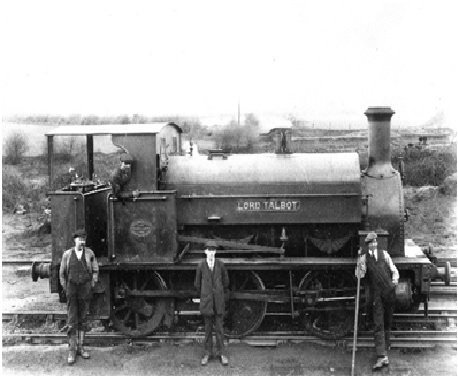The PARKGATE StationS
Parkgate’s First Station
This relatively quiet spot is the starting point for our Parkgate Heritage Trail. It was not always so quiet here, however, for this was once the site of the first railway station to be built in Parkgate.
The Birkenhead Railway, jointly owned by the GWR and the L&NWR, opened a branch from Hooton to Parkgate via Willaston (Hadlow Road) and Neston (South) in 1866. The railway provided this area with its first passenger rail link to Liverpool, still via ferry, and to Chester; it also provided a more efficient means for importing goods and materials and for carrying away local produce to markets elsewhere. Coal became an important traffic when, shortly afterwards, a mineral branch line was built between here and Little Neston to serve the new Neston Colliery, opened in 1874, which was situated close to the shore at the bottom of what is now Marshlands Road – see below.
The first Parkgate Station 1866-86
Parkgate’s Second Station
This first Parkgate station was a terminus, but some years later the Birkenhead Railway decided to continue its line to link with the Wirral Railway at West Kirby, in order to tap new business from west Wirral. This extension, opened in 1886, required the construction of a bridge over Station Road and a new through station on the north side of the road. The site of the old station then became a goods yard with a few sidings, where wagons for the colliery were shunted and reversed. The railway between Hooton and West Kirby was a single track, but the new station was one of four places on the line where there was a loop for trains to cross – the others being Hadlow Road (Willaston), Heswall and Thurstaston.
1912 map, showing Parkgate Station layout
This 1905 view looking north from close by the former signal post on what is now the car park shows, to the left, the 1886 Parkgate station beyond the bridge over Station Road. Centre and right, on Parks Field, is the summer camp of the 4th Lancashire battalion of the Royal Garrison Artillery (Volunteers). In the foreground, right, can be seen the battalion leaving the field with their guns for a practice firing session, probably at the North Parade.
Photo: Arthur Maycock
In 1922 the passenger service at Parkgate was roughly one train an hour in each direction, with just five each way on Sundays, as shown in the timetable below:
Bradshaw’s timetable July 1922
The second Parkgate Station (c 1910)
This photograph, looking towards Neston, shows the second Parkgate Station, which opened in 1886, when the line was extended from here to West Kirby. It seems to have been taken in the summer, as a trio of soldiers appear to be waiting for the arrival of comrades for the annual summer camp. Unlike the other stations on this line this was of wooden construction, probably because of its position on a high embankment.
Photo: Arthur Maycock
Children from Neston and Parkgate used the service every day to attend schools in West Kirby, but, despite the regular service, the railway was never very profitable, and the closure of Neston Colliery in 1927 was a major blow to its viability. After WW2 the expansion of local bus services and the growth of private car ownership drew passengers away from the railway, and in 1956 the passenger service between Hooton and West Kirby ceased. Freight traffic continued for a few more years, but the line was closed completely in 1962, and the track and most of the infrastructure removed a couple of years later.
Colliery Traffic
Coal wagons at Neston (Wirral) colliery, Little Neston.
The mine was part of the north Wales coalfield; the coal was extracted from under the Dee estuary.
Neston Colliery shunter ‘Lord Talbot’,
built c 1880 by Black, Hawthorn & Co, Newcastle
What remains to be seen today?
Type 24 pillbox at Parkgate Station
Situated at the north of this site, overlooking Station Road, is an old World War 2 pillbox, positioned here in 1940 to defend the railway bridge against a possible attack by invading enemy troops, should they be landed on the shore of the Dee estuary and seek to advance this way towards their targets in Wirral. Needless to say, it never saw active use in that conflict. It has recently been fitted out as a home for bats.
Photo: Gillian Lycett
Very little evidence of the old railway can be found here now, except for the former station master’s house, substantially renovated in 2012, still standing by the entrance to the car park.
In the late 1960s the former Cheshire County Council became involved in discussions over the future of the former railway land, which led to the opening in 1973 of the Wirral Way as the nation’s first Country Park, covering the whole of the 12 miles of the route from Hooton to West Kirby. Walkers, cyclists and horse-riders now share use of the Park, which is integrated with other routes; there is a visitor centre at Thurstaston and a preserved station at Hadlow Road, Willaston, while at Lees Lane, Little Neston, there is an attractive picnic site with ponds.
The management of the Park is currently shared between Cheshire West & Chester and Wirral Borough Councils.
The Wirral Country Park – site of the former Parkgate station in
about 2020 Photo: Alan Passmore
From here you can descend the steps by the WW2 pillbox and cross Station Road to visit the little park opposite, at the corner of the Ropewalk, before continuing towards The Parade.
Station Road
Looking down Station Road with the former Chester Hotel on the left (1923)
Historic photos from the David Scott collection, courtesy Burton & Neston History Society;
Tickets: Disused Stations website: www.disused-stations.org.uk
Last Updated December 2022












